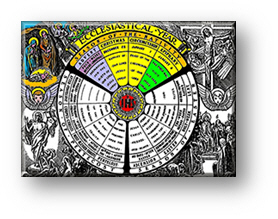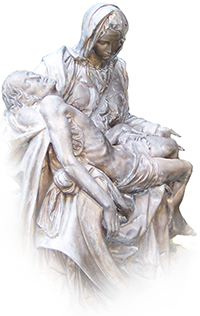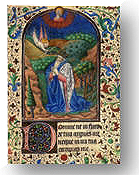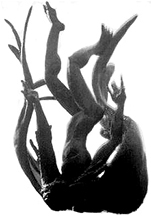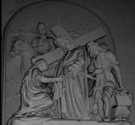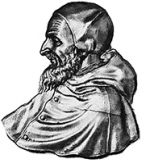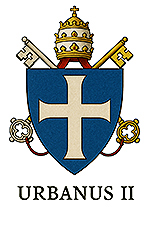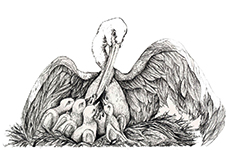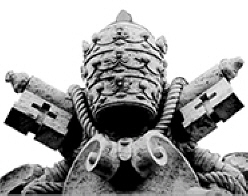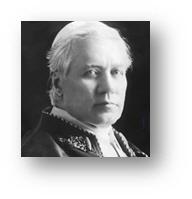This Day, the First Day of February
1. In Phrygia, the commemoration of Saint Tryphonius, martyr.
2. In Ravenna, in the region of Flaminia, Saint Severus, bishop.
3. In the city of Tricastina in the region of France-Vienna, Saint Paul, bishop, from whom the city later took its name.
4. In Kildare, Ireland, Saint Brigid, abbess, who founded one of the first monasteries on this island and is said to have continued the work of evangelization initiated by Saint Patrick.
5. In the Alps of Greece, Saint Ursus, priest.
6. In Anicius, Aquitaine, Saint Agrippanus, bishop and martyr, who is said to have been killed by idolaters while returning to Rome from the borders of Velacum.
7. In Metz, in Austrasia, Saint Sigisbert, King of the Franks, who built the monasteries of Stabulense, Malmundariense, and many others, and generously distributed alms to the Church and the poor.
8. In the town of Ciruelos in the region of New Castile, Spain, Saint Raymond, abbot of Fitero, who was the founder of the Order of Calatrava and a distinguished defender of the Christian faith.
9. In the city of Saint Malo in Britain Minor, Saint John, bishop, who, a man of justice and mercy, transferred the episcopal see to Aleth, and was commended by Saint Bernard for being a poor bishop, a friend of the poor, and a lover of poverty.
10. In Paris, France, blessed Reginald of Aurelian, priest, who, passing through Rome, was captivated by the words of Saint Dominic and entered the Order of Preachers, where by his example and eloquence, he attracted many followers.
11. In Castle Florence in Etruria, Saint Viridian, virgin, who lived in seclusion from childhood to old age.
12. In Pilei, Latium, blessed Andrew of the Counts of Signore, priest of the Order of Friars Minor, who, having refused all higher dignities, preferred to serve Christ in humility and simplicity.
13. In Eblana, Ireland, the blessed martyrs Conor O'Devany, bishop of Dungannon and Connor, and Patrick O'Lougham, priest, both of the Order of Friars Minor, who, condemned by King James I for their Catholic faith, were hanged.
14. In London, England, Saint Henry Morse, priest of the Society of Jesus and martyr, who, after being captured many times and exiled twice, was finally imprisoned by King Charles I for being a priest and gave up his spirit at Tyburn after celebrating Mass.
15. In April, near Angers, France, the passion of the blessed Mary Anne Vaillot and forty-six companions, martyrs 1, who, during the turmoil of the French Revolution, gained the crown of martyrdom.
16. In Seul, Korea, the holy martyrs Paul Hong Yong-ju, catechist, John Yi Mun-u, who ministered to the poor and buried the bodies of martyrs, and Barbara Ch’oe Yong-i, who followed the example of her parents and husband, who were killed for the Christian faith, and was herself decapitated along with others.
17. In the city of Turin, Italy, blessed Johanna Francesca Michelotti, virgin, who founded the Institute of the Sisters of the Sacred Heart, to serve the sick and the poor freely in the Lord.
18. In the city of Cucuta, Colombia, blessed Aloysius Variara, priest of the Salesian Society, who devoted himself to serving lepers with all care, and founded the Sisters of the Sacred Heart of Jesus and Mary.
Feast of the Presentation of the Lord, called by the Greeks Hypapante, on which day, forty days after the Nativity of the Lord, Jesus was brought to the Temple by Mary and Joseph. He appeared to fulfill the Mosaic law, but in truth, He came to meet His believing and rejoicing people, a light for revelation to the Gentiles, and the glory of His people Israel.
1. Aurelianum, in Lyon France, the commemoration of Saint Flosculus, bishop.
5. Florence in Etruria, the commemoration of blessed Simon Fidati of Cassia, priest of the Order of Hermits of Saint Augustine, who by his words and writings led many to a better Christian life.
6. Susa in the Subalpine region, the commemoration of blessed Peter Cambiani of Ruffia, priest of the Order of Preachers and martyr, who was murdered in his monastery by dissenters out of hatred for the Church.
7. Prato in Etruria, the commemoration of Saint Catherine de’ Ricci, virgin of the Third Order Regular of Saint Dominic, who dedicated herself to the work of religious reform and constantly sought to venerate and experience the mysteries of the Passion of Jesus Christ.
12. Dernbach in the Rhineland of Germany, the commemoration of blessed Maria Katharina Kasper, virgin, who founded the Institute of the Poor Handmaids of Jesus Christ, to serve the Lord by serving the poor.
13. Milan in Italy, the commemoration of blessed Andrea Carlo Ferrari, bishop, who fostered the religious tradition of his people and opened new paths by which Christ and the charity of the Church might be known in the world.
14. Verona in Italy, the commemoration of blessed Maria Domenica Mantovani, virgin, who, as the first superior of the Institute of the Little Sisters of the Holy Family, which she founded with blessed Joseph Nascimbeni, priest, serving the poor, the orphans, and the sick in humility out of love for Christ.
Saint Blaise, bishop and martyr, who suffered for the name of Christ at Sebaste in Armenia under the emperor Licinius.
Saint Ansgar, bishop of Hamburg and later also of Bremen in Saxony, who, first a monk of Corbie, was appointed as legate by Pope Gregory IV to all the North. In Denmark and Sweden, he preached the Gospel to many peoples and established the Church of Christ, overcoming many difficulties with a strong spirit, until, worn out by his labors, he rested at Bremen.
3. Jerusalem, the commemoration of Saints Simeon and Anna: the one, an old man, just and God-fearing; the other, a widow and prophetess—who, when the infant Jesus was brought into the Temple to be presented according to the custom of the Law, were deemed worthy to recognize in Him the Messiah and Savior, the blessed hope and redemption of Israel.
4. Carthage, Saint Celerinus, lector and martyr, who in prison, by means of shackles, iron, and various torments, confessed Christ invincibly, following in the footsteps of Celerina, his grandmother, already crowned with martyrdom, and of his uncles, Laurentius and Ignatius, who, once soldiers in the camps but later soldiers of the true God, obtained the palms and crowns of the Lord through His glorious Passion.
5. Poitiers in Aquitaine, Saint Leonianus, priest, who is said to have been a disciple of Saint Hilary.
6. Gap in the Province of France, the Saints Teridius and Remedius, bishops.
7. Lyon in France, Saint Lupicinus, bishop, during the time of the Vandal persecution.
8.In the monastery of Celle in Hainaut, Saint Adelinus, priest and abbot.
9. Chester in Mercia, England, Saint Werburga, abbess of Ely, who founded several monasteries.
10. Merbeek in Brabant, Saint Berlinda, virgin, who led a religious life of poverty and charity in this town.
11. In the Cistercian monastery of Froidmont in the district of Beauvais, France, the commemoration of blessed Helinand, monk, who was once a famous wandering harpist, but later chose a humble and hidden life in the cloister.
12. London in England, blessed John Nelson, priest of the Society of Jesus and martyr, who denied Queen Elizabeth I’s supreme authority in spiritual matters and, for that reason, was condemned to death and hanged at Tyburn.
13. Lyon in France, Saint Mary of Saint Ignatius (Claudine) Thévenet, virgin, who, moved by charity and with a strong spirit, founded the Congregation of the Sisters of Jesus and Mary to educate young women, especially the poor, in Christian virtue.
14. Bourg-Saint-Andéol in the district of Vivarais, France, blessed Mary Anne Rivier, virgin, who, at the very time of the French upheaval when all religious Orders and Congregations were being suppressed, founded the Congregation of the Sisters of the Presentation of Mary to instruct the people of Christ in the faith.
15. In the village of Steyl in the Netherlands, blessed Mary Helena Stollenwerk, virgin, who assisted blessed Arnold Janssen in founding the Congregation of the Missionary Servants of the Holy Spirit, and who, after stepping down from the role of superior, dedicated herself wholly to perpetual adoration.
1. Rome, the Catacombs on the Appian Way, Saint Eutychii, martyr, who, long tormented by insomnia and hunger, and finally thrown into a pit, overcame all the cruel commands of the tyrant for the faith of Christ.
2. In Pamphylia: The holy martyrs Papirius, Diodorus, and Claudianus.
3. Alexandria in Egypt, the passion of the holy martyrs Philere, bishop, and Philoromus, tribune of the soldiers, who, during the persecution of Emperor Diocletian, could not be moved by their relatives and friends to spare themselves. Both, having offered their necks, received the palms of martyrdom from the Lord.
4. Pelusium in Egypt: Saint Isidore, priest, who, renowned for his teaching, despising the world and riches, preferred to imitate the life of John the Baptist in the desert, having taken on the monastic habit.
5. Castellodunum near Chartres in France, the passing of Saint Aventinus, bishop, who previously held the seat of the bishopric of Chartres.
6. In Troyes in France, Lyon: Saint Aventinus, who is regarded as the servant of Saint Lupus, bishop.
7. Mainz in Franconia, Germany, Saint Rabanus, surnamed Maurus, bishop, who, elected from the monastery of Fulda to the See of Mainz, never failed to do whatever he could for the honor of God, a man truly learned, eloquent in speech, and a pontiff beloved by God.
8. Constantinople: Saint Nicholas of Studion, monk, who, often exiled for his defense of the veneration of holy images, was finally made abbot of the Monastery of Studion, where he peacefully rested.
9. Sempringham in England, Saint Gilbert, priest, who, with the confirmation of Pope Eugene III, founded the monastic Order, in which he imposed a dual discipline: the Rule of Saint Benedict for the nuns, and the Rule of Saint Augustine for the clergy.
10. Bourges in Aquitaine: Saint Jeanne de Valois, queen of France, who, finding no way to resolve her marriage bond with King Louis XII, fled to God, displayed singular piety, took up the Cross, and founded the Order of the Annunciation of the blessed Virgin Mary.
11. Durham in England: blessed John Speed, martyr, who, under Queen Elizabeth I, was condemned to death for assisting priests and was crowned with the martyr’s crown.
12. Amatrice in Abruzzo: Saint Joseph of Leonessa, priest of the Order of Friars Minor Capuchins, who sustained Christian captives in Constantinople and, after enduring great hardships, preached the Gospel even in the Sultan’s palace. Upon his return to his homeland, he became notable for his care for the poor.
13. Oriur in the Marava Kingdom in India: Saint John de Brito, priest of the Society of Jesus and martyr, who, living an ascetic life in those parts, converted many to the faith and was crowned with glorious martyrdom.
Memory of Saint Agatha, virgin and martyr, who, in Catania, Sicily, while still a girl, during the persecution, preserved her undefiled body and undivided faith in her martyrdom, bearing witness for Christ the Lord.
2. In Pontus, the commemoration of many holy martyrs in the persecution of Emperor Maximian, who, some being drenched in molten lead, others tortured with sharp reeds in their nails, and many others who suffered repeated torments, merited from the Lord the palm and crown by their illustrious passion.
3. In Vienne, in France Lyon, Saint Avitus, bishop, whose faith and efforts, during the time of King Gundobad, defended France from the infestation of the Arian heresy.
4. In Sabina, in Rhetia, Saint Ingenuinus, the first bishop of this see.
5. In Lucania, Saint Lucretius, abbot under the rule of the holy Eastern fathers, who first led an active monastic life in Sicily, his homeland, and then, because of the invasions of the Saracens, led a wandering life in various places, finally dying in the monastery of Carbonensi of the Saints Elire and Anastasius near Armentum, which he himself founded.
6. In Rome, in the monastery of Saint Crescentius, Saint Sabas the Younger, monk, who, with his brother Saint Macarius, spread the monastic life tirelessly through Calabria and Lucania during the time of the Saracen devastations.
7. In Brixen, in the Trentino region, the commemoration of Saint Albinus, bishop, who transferred the episcopal see from Sabina to this city.
8. In Cologne, in Lorraine, Saint Adelaide, first abbess of the monastery of Vilicensis, where she introduced the Rule of Saint Benedict, and later of the monastery of Saint Mary of Cologne, where she died.
9. In Nagasaki, in Japan, the passion of Saint Paul Miki and twenty-five companions, martyrs, whose memory is celebrated today.
10. In the Valley of Guido, in France, the blessed Francisca Meziere, virgin and martyr, who devoted herself to the instruction of children and the care of the sick, and during the time of the French disturbances was killed out of hatred for the faith.
11. In Rome, the blessed Elisabeth Canori Mora, a mother of a family, who, having long endured the infidelity of her husband, economic hardships, and cruel troubles from her relatives, bore all these with invincible charity and patience, offering her life to the Lord for the conversion of sinners, peace, and holiness, and joining herself to the Third Order of the Most Holy Trinity.
12. In Valtiervilla, in Mexico, Saint Jesus Mendez, priest and martyr, who died for the kingdom of Christ in the Mexican persecution.
This Day, the Sixth Day of February
Memory of Saints Paul Miki and companions 2, martyrs, at Nagasaki in Japan. As the persecution of Christians intensified, twenty-six people — eight priests or religious (from the Society of Jesus or the Order of Friars Minor), whether sent from Europe or born in Japan, and eighteen laypeople—were arrested. After suffering cruel mockery and condemned to death, they were all, including children, nailed to crosses together, rejoicing because it had been granted to them to die in the same manner as Christ.
2. Arvernia in Aquitaine, Saint Antolian, martyr.
This Day, the Seventh Day of February
1. Nola in Campania, Saint Maximus, bishop, who, during the time of persecution, governed the Church of this city and, having completed a long course, died in peace.
2. Lampsacus in the Hellespont, Saint Parthenius, bishop, who, in the time of Emperor Constantine, is said to have spread the faith by his preaching and example of life.
3. In the heights of Mount Sinai, Saint Moses, who first led a solitary life in the desert, then, at the request of Mauvia, queen of the Saracens, was ordained a bishop; he brought the fiercest tribes into peace and preserved the life of Christians unharmed.
4. Florence in Etruria, Saint Juliana, widow.
5. Siponto in Apulia, Saint Lawrence, bishop.
6. Lucca in Etruria, the burial of Saint Richard, father of Saints Willibald and Walburga, who, journeying from England to Rome with his children as a pilgrim, died on the way.
7. Soterium in Phocis, Saint Lucerius the Younger, hermit.
8. Muccia in Picenum of Italy, blessed Riccerius, who was among the earliest and dearest disciples of Saint Francis.
9. Assisi in Umbria, blessed Anthony of Stroncone, religious of the Order of Friars Minor.
10. London in England, blessed Thomas Sherwood, martyr, who, a draper by trade, had already set out for the priesthood at Douai. When he went to London to tend his sick and aged father, he was arrested while walking on the street and led to martyrdom under Queen Elizabeth I.
11. Aubenas in the province of Viviers in France, the blessed martyrs James Sales, priest, and William Saultemouche, religious, of the Society of Jesus, who, strengthening the people in the Catholic faith by their preaching, after the city had been captured by dissenters, were slain before the people on a Sunday for that same faith.
12. Naples in Campania, Saint Giles Mary of Saint Joseph (Francis) Pontillo, religious of the Order of Friars Minor, who each day humbly begged alms from the people in the streets of the city, returning in exchange words of consolation.
13. In the city of Changsha in the Hunan province of China, Saint John of Triora (Francis Mary) Lantrua, priest of the Order of Friars Minor and martyr, who, after enduring long and harsh torments in prison, was strangled by a noose.
14. Paris in France, blessed Rosalie (Jeanne-Marie) Rendu, virgin of the Daughters of Charity, who, in a house established in the poorest district of that city, which she made a refuge for the destitute, devoted all her effort to visiting the poor in their own dwellings, reconciling peace in times of civil war, and inspiring many, especially the young and wealthy, to the exercise of charity.
15. Likewise, there, blessed Mary of Providence (Eugénie) Smet, virgin, who founded the Institute of the Sisters for the Assistance of Souls in Purgatory.
16. Rome, blessed Pope Pius IX, who, fully proclaiming the truth of Christ to which he adhered from the depths of his heart, established many episcopal sees, promoted the devotion to the Blessed Virgin Mary, and convened the First Vatican Ecumenical Council.
17. the place Pont de Molins near Gerona in Spain, the blessed martyrs Anselm Polanco, bishop of Teruel, and Philip Ripoll, priest, who, spurning both allurements and threats, never fell from their loyalty to the Church.
18. Near Krakow in Poland, blessed Adalbert Nierychlewski, priest of the Congregation of Saint Michael and martyr, who, after Poland was subjected to a military regime hostile to human dignity and religion, was deported for his faith in Christ to the death camp of Oswiecim, or Auschwitz, where he died, racked by torture.
19. In the detention camp of the town of Angarsk in the Siberian province of Russia, blessed Peter Verhun, priest and martyr, who, in a time of persecution against religion, achieved eternal life through a faithful death.
This Day, the Eighth Day of February
Saint Jerome Emiliani, who, having spent his youth in anger and dissipation, was thrown into prison by enemies. There he turned to God; afterwards, he gave himself entirely—along with companions who gathered around him—to all those cast into misery, especially orphans and the sick. This was the beginning of the Congregation of Clerics Regular known as the Somaschans. Struck down by the plague while caring for the afflicted, he died at Somasca near Bergamo in Lombardy.
Saint Josephine Bakhita, virgin, who, born in the region of Darfur in Sudan, was abducted as a little girl and sold many times in African slave markets, suffering cruel slavery. last freed, she became a Christian in Venice and a religious among the Daughters of Charity, and spent the rest of her life in Christ, serving all in the town of Schio in the Vicenza region of Italy.
3. Alexandria in Egypt, the commemoration of Saint Cointha, martyr, whom pagans under the emperor Decius led to the idols, forcing her to worship. When she rejected this with horror, they tied ropes to her feet and dragged her bound through the streets of the city, tearing her apart in a terrible torture.
4. Pavia in Liguria, Saint Juventius, bishop, who labored vigorously for the Gospel.
5. The commemoration of the holy martyr monks of the monastery of Dios at Constantinople, who, for defending the Catholic faith, were cruelly slain after bringing the letters of Pope Saint Felix III against Acacius.
6. In Brittany, Saint Jacut, abbot, who is said to have been the brother of Saints Winwaloe and Guethnoc. He founded a monastery near the sea, later called by his name.
Milan in Lombardy, the burial of Saint Honoratus, bishop, who, when the threat of the Lombards was imminent, preserved a great part of the people by leading them to take refuge in Genoa.
8. Besançon in Burgundy, Saint Nicetius, bishop.
9. Verdun in France, Saint Paul, bishop, who, having become a monk, was later raised to the Church of Verdun. He promoted the dignity of divine worship and the regular life of the canons.
10. Albano in Latium, blessed Peter, surnamed Igneus, because he passed unharmed through fire; a monk of Vallombrosa and later bishop of Albano, who labored unceasingly to restore ecclesiastical discipline.
11. Muret in the territory of Limoges in Aquitaine, Saint Stephen, abbot, founder of the Order of Grandmont, who entrusted divine praise and contemplation to the clerics, and the care of temporal matters in charity to the lay brothers alone.
12. Savona in the Piedmont region of Italy, blessed Josephine Gabriella Bonino, virgin, who, under the inspiration of the Holy Family of Nazareth, founded a religious congregation for the education of orphans and the care of the poor sick.
This Day, the Ninth Day of February
1. Alexandria in Egypt, the commemoration of Saint Apollonia, virgin and martyr, who, after many and cruel tortures from her persecutors, when she refused to utter impious words, preferred to be thrown into the flames rather than fall away from the faith.
2. Likewise at Alexandria, the passion of many holy martyrs, who, while they were celebrating the synaxis in church, were killed in various ways by the Arians.
3. Lemella in Africa, the commemoration of Saints Primus and Donatus, deacons and martyrs, who were also slain by heretics while defending the altar in the church.
4. On a mountain near Apamea in Syria, Saint Maron, hermit, greatly devoted to severe penance and to the interior life, at whose tomb a celebrated monastery was built, from which the nation later attributed to his name took its origin.
5. In the monastery of Llandaff in Wales, Saint Teilo, bishop and abbot, whose extraordinary labors are celebrated by many churches both in Wales and Cornwall as well as in Armorica.
6. Canosa in Apulia, Saint Sabinus, bishop, who was a friend of Saint Benedict and was sent as a legate of the Roman See to Constantinople, to defend the true faith against the Monophysite heresy.
7. Altomonte on the Sambre in Hainaut, the passing of Saint Ansbert, who was abbot of Fontenelle and later bishop of Rouen, exiled by Prince Pepin.
8. In Bavaria, the commemoration of Saint Alto, abbot, who, born in Ireland, built a monastery in the forest of that region, which was later called by his name.
9. Nocera in Umbria, Saint Raynald, bishop, formerly a monk of Camaldoli at Fonte Avellana, who, while exercising the episcopal office, steadfastly retained the habit of monastic life.
10. Premià de Mar near Barcelona in Spain, Saint Michael (Francisco Luis) Febres Cordero, religious of the Brothers of the Christian Schools, who promoted the study of letters for nearly forty years in the city of Cuenca in Ecuador, and then in Spain devoted himself with a simple spirit to the perfect observance of the rule.
This Day, the Tenth Day of February Commemoration of the passing of Saint Scholastica, virgin, who was the sister of Saint Benedict and, dedicated to God from childhood, shared one mind with her brother in God, so that once each year, at the monastery of Monte Cassino in Campania, they would spend the whole day in praises of God and sacred conversation.
2. Magnesia in the province of Asia, the holy martyrs Charalampius, Porphyrius, Daucus, and three women, martyred under the emperor Septimius Severus.
3. Rome, on the Labican Way, at the tenth milestone from the city, the holy martyrs Zoticus and Amantius.
4. Near Terracina in Campania, Saint Silvanus, bishop.
5. Saintes in Aquitaine, Saint Trojanus, bishop.
6. Besançon in Burgundy, Saint Prothadius, bishop.
7. In the region of Rouen in Neustria, Saint Austreberta, virgin and abbess, who devoutly governed the monastery of Pavilly, recently founded by Saint Audoin, bishop.
8. In the cave of Stabulum Rhodis near Roseto in Etruria, Saint William, hermit of Malavalle, from whose example many eremitical congregations took their origin.
9. In the Premonstratensian monastery of Fosses near Namur in Lotharingia, blessed Hugh, abbot, to whom Saint Norbert, having become bishop of Magdeburg, entrusted the establishment of the new Order, which he governed with great wisdom for thirty-five years.
10. Rimini in Flaminia, blessed Clara, widow, who, after having lived a sinful life, made atonement through penance, mortification of the flesh, and fasting, and gathering companions in a monastery, served the Lord in a spirit of humility.
11. Avrillé near Angers in France, blessed Peter Fremond and five companions,3 virgins and martyrs, who, during the French turmoil, were killed by bullets for remaining faithful to the Catholic Church.
12. In Valle Verde de Camino near Huelva in the Bætica region of Spain, blessed Eusebia Palomino Yenes, virgin of the Institute of the Daughters of Mary Help of Christians, who, offering an outstanding example of humility, without seeking any show of greatness, attained the heights of grace through her spirit of self-denial in her most humble tasks.
13. In the town of Krašić near Zagreb in Croatia, blessed Aloysius Stepinac, bishop of Zagreb, who bravely opposed doctrines that denied both faith and human dignity, and because of his fidelity to the Church, was imprisoned for a long time, until struck by illness and worn out by deprivation, he brought to fulfillment an outstanding episcopate.
This Day, the Eleventh Day of February Blessed Virgin Mary of Lourdes, whom, in the fourth year after the proclamation of the Immaculate Conception of the Blessed Virgin, the humble girl Saint Mary Bernadette Soubirous frequently saw in the hollow of the rock of Massabielle, in the Pyrenean mountains near the bank of the Gave de Pau, close to the town of Lourdes. For this reason, countless crowds of the faithful devoutly flock there.
2. Rome, on the Appian Way, in the cemetery named after her, Saint Soteris, virgin and martyr, who, as Saint Ambrose recounts, set aside the nobility of her family and the honors of faith, and when commanded to sacrifice, did not yield; she did not lower her gaze at frequent insults from slaves, nor did she shrink from death when condemned to the sword.
3. Commemoration of many holy martyrs, who were arrested in Numidia during the persecution under the emperor Diocletian, and who, refusing to hand over the Holy Scriptures contrary to the emperor’s edict, were tortured with cruel torments and died.
4. Volturno in Campania, Saint Castrensis, martyr.
5. In Apulia, Saint Secundinus, bishop.
6. In Châteaulaudon in France, Saint Severinus, abbot of Agaunum.
7. Rome, near Saint Peter’s, the burial of Saint Gregory II, pope, who, in the calamitous times of the emperor Leo the Isaurian, defended the Church and the veneration of sacred images, and sent Saint Boniface to preach the Gospel in Germany.
8. Likewise, there, the burial of Saint Paschal I, pope, who brought up many bodies of holy martyrs from the catacombs, desiring to transfer them out of devotion, and placed them with honor in various churches of the City.
9. In Burgundy, Saint Ardanus, abbot of Tournus.
10. In Chihuahua, Mexico, Saint Peter Maldonado, priest and martyr, who, during a raging persecution, faithfully upheld the mystery of the Eucharist to the end, and was struck on the head and thus merited to attain the triumph of martyrdom.
In loco Vinaroz in Castélla Hispániæ regiónis, beáti To Hire (Francísci) Borrás Romeu, religiósi ex Ordine Hospitalário Sancti Ioánnis a Deo et mártyris, qui persecutiónis témpore in ódium fídei gloriósum certámen consummávit.
11. Vinaroz in the Castile region of Spain, blessed Brother Tobias (Francisco) Borrás Romeu, religious of the Order of Saint John of God and martyr, who, in time of persecution, completed a glorious struggle against hatred for the faith.
This Day, the Twelfth Day of February
1. At Carthage, the commemoration of the holy martyrs of Abitina 4, who, during the persecution of the emperor Diocletian, had gathered, contrary to the emperor’s edict, to celebrate the Lord’s Day as was customary; they were seized by the magistrates of the colony and by the stationed military guard, and brought to Carthage, and after being questioned by the proconsul Anulinus, they all confessed themselves to be Christians even under torture, declaring that the sacrifice of the Lord could not be omitted; wherefore, in various places and at different times, they poured out their most blessed blood
2. Commemoration of Saint Meletius, bishop of Antioch, who, on account of his adherence to the Nicene faith, was often subjected to exile, and who soon, while presiding over the First Ecumenical Council of Constantinople, passed on to the Lord; his virtues were extolled with the highest praises by Saints Gregory of Nyssa and John Chrysostom.
3. In the Monastery of St. Cornelius in Inden Germany, the passing of Saint Benedict, abbot of Aniane. He promoted the Rule of Saint Benedict, propagated the Rule of Saint Benedict, handed down customs to be observed to the monks, and labored much in restoring the Roman liturgy.
4. Constantinople, Saint Anthony, also called Caulphæ, bishop, who under Emperor Leo III the Isaurian labored zealously to preserve peace and unity in the Church.
5. In the abbey of Juliacum in the region of Gallia Trecensis, blessed Humbeline, prior of that same monastery. Having been called from worldly pleasures by her brother, Saint Bernard of Clairvaux, with the consent of her husband, she embraced the monastic life.
6. In the village of Northeim in Alsace, Saint Lucian, who, born in Scotland, on a pilgrimage to the tombs of the apostles, passed to the Lord.
7. In London, the holy martyrs Thomas Hemerford, James Fenn, John Nutter, John Munden, and George Haydock, priests, who, under Queen Elizabeth I, who asserted spiritual primacy, were condemned to death for fidelity to the Roman Church, and at Tyburn, even while still breathing, were eviscerated.
This Day, the Thirteenth Day of February
1. Athens in Greece, Saint Martinian, who had formerly led a hermit's life near Caesarea in Palestine.
2. Cardon on the Moselle, in the territory of Trier, Saint Castor of Aquitaine, priest and hermit.
3. Todi in Umbria, Saint Benignus, priest and martyr.
4. Lyon in France, Saint Stephen, bishop.
5. Rieti in the Sabine region, the commemoration of Saint Stephen, abbot, a man of remarkable patience [“at whose death, as is related by the blessed Pope Gregory, the holy angels were present and visible to all.” 1913 editio typica].
6. Osnabrück in Saxony, Germany, Saint Gosbert, bishop of the Suebi, who, driven from his see by a pagan persecution, took up the governance of the Church of Osnabrück.
7. Carcassonne in Narbonese France, Saint Guimene, bishop.
8. Likewise, at Luteva in Narbonese France, Saint Fulcranius, bishop, noted for his mercy toward the poor and his zeal for divine worship.
9. Meaux in the region of Brie in France, Saint Gilbert, bishop.
10. Near Ptolemais in Palestine, the passing of blessed Jordan of Saxony, priest of the Order of Preachers, who, successor and imitator of Saint Dominic, worked with great zeal to spread the Order and died in a shipwreck.
11. Spoleto in Umbria, blessed Christina (Augusta) Camozzi, who, after the death of her husband, once gave in to carnal desire, but soon embraced a life of penance in the Secular Order of Saint Augustine, devoting herself to prayer and the service of the sick and the poor.
12. Padua in Venetia, blessed Eustochia (Lucretia) Bellini, virgin of the Order of Saint Benedict.
In locō Dongjiaochang apud urbem Lezhi in prōvinciā Sichuan Sinarum, sanctī Paulī Liu Hanzuo, presbyteri et martyris, ob christiānum nōmen strangulātī.
13. Dongjiaochang near the city of Lezhi in the province of Sichuan, China, Saint Paul Liu Hanzuo, priest and martyr, strangled because of the name of Christ.
In civitāte Thủ-Nghẹ in Cocīncīnā, sanctī Paulī Le-Van-Lộc, presbyteri et martyris, quī sub imperātōre Tự Đức ad portam civitātis pro Christō decollātus est.
14. In the city of Thủ-Nghẹ in Cochinchina, Saint Paul Lê-Văn-Lộc, priest and martyr, who, under the emperor Tự Đức, was beheaded at the city gate for Christ.
This Day, the Fourteenth Day of February
Memorial of Saints Cyril, monk, and Methodius, bishop. These brothers from Thessalonica, sent by Photius, bishop of Constantinople, preached the Christian faith in Moravia and devised their own characters of letters so that they might translate the sacred books from Greek into the Slavonic tongue. When they came to Rome, Cyril, who had previously been called Constantine, fell ill, became a monk, and on this day fell asleep in the Lord there. Methodius, however, ordained bishop of Sirmium by Pope Adrian II, tirelessly evangelized Pannonia, endured many accusations brought against him, but was always assisted by the Roman Pontiffs; he received the reward of his labors at Velehrad in Moravia, on the sixth day of April.
2. Rome, on the Via Flaminia near the Milvian Bridge, Saint Valentine, martyr.
3. Spoleto in Umbria, Saint Vitalis, martyr, whom steadfast faith and the imitation of Christ made holy.
4. Rome, in the cemetery of Praetextatus on the Appian Way, Saint Zeno, martyr.
5. Alexandria in Egypt, the commemoration of the holy martyrs Bassianus, Tonion, Pratus, and Lucius, who were cast into the sea; of the priest Cyrion, the exorcist Agathon, and Moses, who were burned with fire; and of Dionysius and Ammonius, who were slain by the sword and entered into eternal glory.
6. Ravenna in Flaminia, Saint Eleuchadius, bishop.
7. On Mount Scopas in Bithynia, Saint Auxentius, priest and archimandrite, who, placed on a high place as if upon a throne, defended the faith of Chalcedon with the power of his voice.
8. Commemoration of Saint Nostrianus, bishop of Naples.
9. Sorrento in Campania, Saint Antoninus, abbot, who, after his monastery was devastated by the Lombards, withdrew into solitude.
10. Córdoba in Spain, Saint John the Baptist of the Conception García, priest of the Order of the Most Holy Trinity, who undertook the reform of the Order, which he carried out with great zeal amid severe labors and cruel adversities.
11. Valencia in Spain, blessed Vincent Vilar David, martyr, who, during a religious persecution, welcomed priests and religious into his home and chose to die rather than deny the faith.
This Day, the Fifteenth Day of February
1. Commemoration of blessed Onesimus, whom Saint Paul the Apostle received as a fugitive slave and, while in chains, begot in the faith as a son in Christ, as he himself wrote to his master Philemon.
2. Brescia in Venetia, the holy martyrs Faustinus and Jovita, who, after many trials endured for the faith of Christ, received the victorious crown of martyrdom.
3. Antioch in Syria, the holy martyrs Isicius, priest, Joseph the Roman deacon, Zosimus, Baralus, and Agape, virgin.
4. Auvergne in Aquitaine, Saint Georgia, virgin.
5. Vaison in Lugdunese France, Saint Quininus, bishop.
6. In the valley of Interocrina in the province of Valeria in Italy, Saint Severus, priest, whose memory is preserved by Saint Gregory the Great, pope.
7. Capua in Campania, Saint Decorosus, bishop.
8. Palazzolo in Etruria, Saint Walfrid, abbot, who, having fathered five children, resolved with his wife to embrace the monastic life.
9. Växjö in Sweden, Saint Sigfrid, bishop, who, originally from England, evangelized the peoples of this region with great diligence and baptized King Olaf himself in Christ.
10. Borgo San Sepolcro in Umbria, blessed Angelo Scarpetti, priest of the Order of Hermits of Saint Augustine.
11. Paray-le-Monial in Burgundy, France, Saint Claude La Colombière, priest of the Society of Jesus, who, being a man greatly dedicated to prayer, led many to the love of God by his steadfast and upright counsel.
This Day, the Sixteenth Day of February
1. In Campania, Saint Juliana, virgin and martyr.
2. Caesarea in Palestine, the holy martyrs Elias, Jeremiah, Isaiah, Samuel, and Daniel, who were Egyptian Christians. When they had voluntarily ministered to confessors of the faith who were condemned to the mines in Cilicia, they were arrested and, under the governor Firmilian during the reign of the emperor Galerius Maximian, were most savagely tortured and finally struck down by the sword. After them, there also received the crown of martyrdom: Pamphilus, priest; Valens, deacon of Jerusalem; and Paul, originally from the city of Jamnia, who had spent two years in prison; and also Porphyrius, the servant of Pamphilus; Seleucus, a Cappadocian, promoted in military rank, Theodulus, an old man from the household of Governor Firmilian; and finally Julian, a Cappadocian, who, arriving at that very hour as a traveler, kissed the bodies of the martyrs and was reported as a Christian, and the governor ordered him to be burned with a slow fire.
3. In the Persian kingdom, Saint Maruthas, bishop, who, after peace was restored to the Church, presided over the Council of Seleucia, restored churches of God that had collapsed during the persecution under King Shapur, and placed the relics of Persian martyrs in his episcopal city, which was thereafter called Martyrópolis.
4. Borgo San Pietro in the Abruzzi, blessed Philippa Mareri, virgin, who, scorning riches and the pomp of the world, embraced in her native place the way of life recently begun by Saint Clare.
5. Perugia in Umbria, the commemoration of blessed Nicholas Paglia, priest of the Order of Preachers, who received the habit and mission of preaching from Saint Dominic himself.
6. Turin in Italy, blessed Joseph Allamano, priest, who, burning with tireless zeal, founded two Missionary Congregations of the Consolata, for both men and women, for the spreading of the faith.
This Day, the Seventeenth Day of February
Seven Holy Founders of the Order of the Servants of Mary, namely Bonfilius, Bartholomew, John, Benedict, Gerardino, Ricovero, and Alexis, who, previously merchants in Florence, withdrew together by common decision to Mount Senario and devoted themselves to the Blessed Virgin Mary, founding an Order under the Rule of Saint Augustine. They are commemorated on the same day, on which the survivor among them, Alexis, is said to have died at the age of one hundred.
2. Amasea in the Hellespont, the passion of Saint Theodore Tiro, who, in the time of the Emperor Maximian, was bravely scourged for his confession of the Christian faith, then cast into prison, and finally handed over to be burned in the flames. Saint Gregory of Nyssa praised him with a remarkable encomium.
3. Trier in Belgic France, Saint Bonosus, bishop, who, together with Saint Hilary of Poitiers, labored with zeal and learning to preserve the integrity of the faith in the regions of France.
4. In Armenia, Saint Mesrop, doctor of the Armenians, who, a disciple of Saint Narses and a scribe in the royal palace, became a monk and created a written script so that the people might be instructed in the Holy Scriptures; he translated both Testaments and composed hymns and other songs in the Armenian language.
5. In the monastery called Cluain Ednech in Ireland, Saint Fintan, abbot, founder of that same monastery, renowned for his austerity.
6. Commemoration of Saint Flavian, bishop of Constantinople, who, after defending the Catholic faith at Ephesus, was struck with fists and kicks by the faction of the impious Dioscorus and, being condemned to exile, died shortly afterward from the violence of the assault.
7. Lindisfarne in Northumbria, Saint Finan, bishop and abbot, wonderfully endowed with teaching and zeal for evangelization.
8. Auchy-les-Moines, the burial of Saint Silvinus, bishop.
9. In the monastery of Cava in Campania, Saint Constabilis, abbot, who, because of his exceptional gentleness and charity toward all, was commonly called “the covering” of the brethren.
10. Ratzeburg in Holstein, Germany, Saint Evermod, bishop, who, a disciple of Saint Norbert in the Order of Premonstratensians, devoted himself to the conversion of the Wends.
11. Padua in the Veneto, blessed Luke Belludi, priest of the Order of Friars Minor, who was a disciple and companion of Saint Anthony.
12. Pyongyang in Korea, Saint Peter Yu Chong-nyul, martyr, who, a father of a family, was arrested while reading the Gospel by night to assembled faithful in the home of a catechist, and, having been scourged with rods unto death, died for Christ.
13. Rosica in Poland, blessed Anthony Leszczewicz, priest of the Congregation of Marian Clerics and martyr, who, during the military occupation of that land in wartime, was burned alive by persecutors of the Church because of his faith in Christ.
This Day, the Eighteenth Day of February
1. In the place Beth Lapat in the kingdom of the Persians, the passion of the holy martyrs Sadoth, bishop of Seleucia in Persia, and one hundred twenty-eight companions, who, being priests, clerics, and consecrated virgins, when they refused to worship the sun, were cast into chains and, after enduring horrible tortures for a very long time, were finally slain by sentence of the king.
2. Toledo in Spain, Saint Helladius, who, first a courtier of the king and administrator of public affairs, became abbot of Agali and was at last raised to the episcopate of Toledo, where he gave remarkable examples of his charity.
3. Constantinople, Saint Tarasius, bishop, distinguished for his learning and piety, who opened the Second Council of Nicaea, in which the Fathers defended the veneration of holy images.
4. In the monastery of Centula in the district of Amiens in France, Saint Angilbert, abbot, who, having left behind courtly and military offices, his wife Bertha consenting, who herself received the sacred veil, devoted himself to the monastic life and happily governed the monastery of Centula.
5. Coimbra in Portugal, Saint Theotonius, who made pilgrimage twice to Jerusalem and, having refused guardianship of the Holy Sepulchre, returned to his homeland and founded the Congregation of Canons Regular of the Holy Cross.
6. Rome, blessed John of Fiesole, surnamed the Angelic [Fra Angelico], priest of the Order of Preachers, who, always adhering to Christ, expressed in paintings what he contemplated inwardly, so as to lift men's minds to heavenly things.
7. London in England, blessed William Harrington, priest and martyr, who, born in the county of York, was condemned to death under Queen Elizabeth I for having received and exercised the priesthood in England, and obtained the crown of martyrdom at Tyburn.
8. Likewise, near London in England, blessed John Pibush, priest and martyr, who, having been imprisoned many times and for long periods, was eventually condemned to death under the same queen for being a priest; he was hanged at Southwark and disemboweled while yet alive.
9. In the city of Wuchang, in the province of Hubei in China, Saint Francis Regis Clet, priest of the Congregation of the Mission and martyr, who for thirty years preached the Gospel amid great hardships, and, after bitter captivity, deceived by an apostate, was strangled for the name of Christ.
10. In the city of Guizhou, likewise in China, Saint John Peter Neel, priest of the Paris Foreign Missions Society and martyr, who, being accused of preaching the faith, was tied to a horse’s tail and dragged at full gallop, subjected to every kind of mockery and torment, and at last beheaded. With him, also suffering martyrdom: Saints Martin Wu Xuesheng, catechist, John Zhang Tianshen, a neophyte, and John Chen Xianheng.
11. Bergamo in Italy, blessed Gertrude (Catherine) Comensoli, virgin, who founded a religious Congregation for the adoration of the Most Blessed Sacrament and for the instruction of youth.
12. Rosica in Poland, blessed George Kaszyra, priest of the Congregation of Marian Clerics and martyr, who, during a time of war, was put to death by fire by persecutors of the faith, and died for Christ the Lord.
This Day, the Nineteenth Day of February
1. Naples in Campania, the burial of Saint Quodvultdeus, bishop of Carthage, who, together with his clergy, was cast into exile by the Arian king Genseric and placed on ruined ships without sails or oars. Beyond hope, he landed at Naples and there died as a confessor of the faith.
2. Commemoration of the holy monks and other martyrs, who in Palestine were most cruelly slaughtered by the Saracens under the leader Alamundarus, because of their faith in Christ.
3. Milan in Lombardy, Saint Mansuetus, bishop, who fought vigorously against the heresy of the Monothelites.
4. Near Benevento in Campania, Saint Barbatus, bishop, who is said to have converted the Lombards and their leader to Christ.
5. In the monastery of Vabres in the district of Rouergue in Aquitaine, Saint George, monk.
6. Bisignano near Cosenza in Calabria, Saint Proclus, monk, who, endowed with outstanding learning, was a herald of monastic life.
7. Cambron near Brussels in Brabant, the burial of blessed Boniface, formerly bishop of Lausanne, who lived an ascetic life among the Cistercian nuns of that place.
8. Noto in Sicily, blessed Conrad of Piacenza Confalonieri, hermit of the Third Order of Saint Francis, who, having cast off worldly amusements, pursued a most austere way of life for nearly forty years in constant prayer and penance.
9. Córdoba in the region of Andalusia in Spain, commemoration of blessed Álvaro, priest of the Order of Preachers, notable for his preaching and contemplation of the Lord’s Passion.
10. Mantua in Lombardy, blessed Elisabeth Picenardi, virgin, who, under the habit of the Order of the Servants of Mary, led a life consecrated to God in her father’s house, frequently receiving Holy Communion and diligently devoting herself to the Liturgy of the Hours and the meditation of Scripture, with deepest devotion to the Virgin Mary.
11. In the place Kaiyang near Mianyang in the Sichuan province of China, Saint Lucia Yi Zhenmei, virgin and martyr, who was condemned to beheading for her confession of the Catholic faith.
12. In the Dachau detention camp near Munich in Bavaria, Germany, blessed Joseph Zaplata, religious of the Congregation of the Sacred Heart of Jesus and martyr, who, forcibly taken from his native Poland and given over into cruel imprisonment for the sake of the faith, contracted illness and fulfilled his martyrdom.
This Day, the Twentieth Day of February
1. Alexandria, the commemoration of Saint Serapion, martyr, who, under Emperor Decius, was subjected to such extremely cruel tortures that all the joints of his limbs were first broken, and then he himself was thrown down from the upper parts of his own house.
2. Commemoration of five blessed martyrs, who, under Emperor Diocletian, were killed at Tyre in Phoenicia. First, their whole bodies were torn by scourges; then they were stripped and placed in the arena and given over to various kinds of wild beasts. Yet they showed firm and unshaken constancy in their youthful bodies. One of them especially, not yet twenty years old, not bound by any chains, with his arms stretched out in the form of a cross, was offering prayers to God. All of them, preserved unharmed by the beasts that had been provoked beforehand, were at last killed by the sword.
3. Antioch in Syria, the commemoration of Saint Tyrannion, bishop of Tyre and martyr, who, having been instructed in the Christian faith from early youth, was torn with iron claws together with the presbyter Zenobius, and received the laurel [of victory and martyrdom].
4. Tournai in Belgic France, Saint Eleutherius, bishop.
5. the monastery of Saint Trudo in Brabant of Austrasia, the passing of Saint Eucherius, bishop of Orléans, who, having been driven into exile by Duke Charles Martel due to the slanders of the envious, found pious refuge among monks.
6. Catania in Sicily, Saint Leo, bishop, who took the greatest care for the poor.
7. the place Aljustrel near Fatima in Portugal, blessed Jacinta Marto, who, although still a girl of tender age, patiently endured the ravages of the illness with which she was afflicted and bore devoted witness with all diligence to her love for the Blessed Virgin Mary.
8. the place Stutthof near Gdańsk in Poland, blessed Julia Rodzińska, virgin of the Congregation of the Sisters of Saint Dominic and martyr, who, when her homeland was devastated by war, was cast into a detention camp, where, afflicted with a fatal disease, she came to heavenly glory.
This Day, the Twenty-first Day of February
Saint Peter Damian, Cardinal Bishop of Ostia and Doctor of the Church, who, having entered the hermitage of Fonte Avellana, vigorously promoted the religious life, and in times difficult for the advancement of the reform of the Church, resolutely recalled monks to the holiness of contemplation, clerics to the integrity of life, and the people to communion with the Apostolic See. His passing occurred at Faenza in Flaminia on a holy day.
2. Commemoration of Saint Eustathius, Bishop of Antioch, who, renowned for his teaching, was driven into exile at Traianopolis in Thrace under the Arian emperor Constantius for his defense of the Catholic faith, and there he rested in the Lord.
3. In the monastery of Grandval in Switzerland, Saint Germanus, abbot, who, when he wished with peaceful words to defend the inhabitants of the monastery who had been attacked by a band of marauders, was stripped of his garments and run through with a spear, and fell together with Saint Randoald, a monk.
4. In London, England, blessed Thomas Pormort, priest and martyr, who, under Queen Elizabeth I, was cruelly tortured in prison because of his priesthood, and then at St. Paul’s fulfilled his martyrdom by hanging.
5. Likewise, there, Saint Robert Southwell, priest of the Society of Jesus and martyr, who for many years carried out his ministry in this city and the surrounding region, and composed spiritual poetry, until at length, having been captured because of his priesthood, he was most cruelly tortured by order of the same queen, and completed his martyrdom by the noose at Tyburn.
6. Angers in France, blessed Noël Pinot, priest and martyr, who, a parish priest during the turmoil of the French Revolution, was arrested as he was preparing to celebrate Mass and, clothed in sacred vestments for mockery, was led to the scaffold as though to the Altar of Sacrifice. 7. Turin in the Subalpine region, blessed Mary Henrietta (Anne Catherine) Dominici, of the Sisters of St. Anne and of Providence, who wisely led and expanded the Institute for thirty years until her death.
This Day, the Twenty-second Day of February
Feast of the Chair of Saint Peter, Apostle, to whom the Lord said: “Thou art Peter, and upon this rock I will build my Church.” On the day when the Romans were accustomed to commemorate their deceased, the natal seat of that Apostle is celebrated, which glories in his tomb in the Vatican field and is called to preside over the whole fellowship of charity.
2. Hierapolis in Phrygia, Saint Papias, bishop, who, a hearer of John the Elder and companion of Polycarp, explained the words of the Lord.
3. Vienne in France of Lyon, Saint Paschasius, bishop, outstanding for his learning and the holiness of his life.
4. Ravenna in Flaminia, Saint Maximian, bishop, who faithfully fulfilled the pastoral office and defended the unity of the Church against heretics.
5. Faenza in Flaminia, the heavenly birthday of Saint Peter Damian, whose memorial is observed on the day before this.
6. Longchamp in the suburbs of Paris in France, blessed Isabelle, virgin, who, sister of Saint Louis IX, King of France, having spurned royal marriage and the delights of the world, founded a monastery of Poor Clare Sisters, with whom she served God in humility and poverty.
7. Cortona in Etruria, Saint Margaret, who, deeply shaken by the death of her lover, washed away the stains of her youthful years with saving penance and, having been received into the Third Order of Saint Francis, withdrew into wondrous contemplation of heavenly things, adorned by God with heavenly charisms.
8. In the city of Sendai in Japan, blessed Diego Carvalho, priest of the Society of Jesus and martyr, who, after injuries, imprisonments, and harsh journeys completed during winter, finally, in the torture of freezing water, confessed Christ with unwavering faith, together with many companions.
9. Florence in Etruria, blessed Mary of Jesus (Émilie) d’Oultremont, who, in Belgium, the mother of four children, having become a widow, by no means neglected her maternal duties, but gave herself to founding and governing the Society of the Sisters of Mary Reparatrix, and, trusting in divine aid, overcame not a few difficulties.
This Day, the Twenty-third Day of February
Memorial of Saint Polycarp, bishop and martyr, who is honored as the disciple of blessed John and the last witness of apostolic times. Under the emperors Marcus Antoninus and Lucius Aurelius Commodus, in Smyrna of Asia, he was handed over to the fire in the amphitheater before the proconsul and all the people, being nearly ninety years of age, giving thanks to God the Father that He had deemed him worthy to be counted among the martyrs and to receive a share in the chalice of Christ.
2. Sirmium in Pannonia, Saint Sirenus, or Sinerus, martyr, who, a gardener, was denounced by a certain woman whom he had reproved for acting immodestly. Arrested by the judge, he confessed that he was a Christian and, since he refused to sacrifice to the gods, was beheaded.
3. Wenlock in England, Saint Milburga, virgin and abbess of the monastery at that place, of the royal line of the Mercians.
4. Mainz in Franconia, Germany, Saint Willigis, bishop, outstanding for his pastoral zeal.
5. Stilo in Calabria, Saint John, who, having become a monk under the discipline of the Eastern Fathers, merited to be called Theristes or the Reaper, because, moved by great charity toward the poor, he was accustomed to assist the reapers.
6. Flaviobriga in the Basque region of Spain, blessed Rafaela de Villalonga Ybarra, who, mother of seven children, with the consent of her husband, made religious vows and founded the Institute of the Guardian Angel Sisters to protect young girls and lead them in the way of the Lord’s commandments.
7. Off the coast of Rochefort in France on a prison ship, blessed Nicolas Tabouillot, priest and martyr, who, a parish priest, during the turmoil of the French Revolution, was imprisoned for being a priest and eventually died from illness in the city infirmary.
8. Rome, blessed Josephine (Judith Adelaide) Vannini, virgin, who founded the Congregation of the Daughters of Saint Camillus to serve the sick.
9. Poznań in Poland, blessed Ludwik Mzyk, priest of the Society of the Divine Word and martyr, who, during his country’s military occupation by followers of a wicked doctrine hostile to the faith, was slaughtered by the guards of the fortress, bearing witness to Christ even unto death.
10. In the detention camp of Dachau near Munich in Bavaria, Germany, blessed Vincent Frelichowski, priest, who, in that time of war, having been deported through various prisons, never turned aside from the faith or from his pastoral office, and, falling ill while attending the sick in the infirmary, after long sufferings reached the vision of eternal peace.
This Day, the Twenty-fourth Day of February
1. Nicomedia in Bithynia, the passion of Saint Evetius, who, under the emperor Diocletian, as soon as he saw the edicts against the worshipers of God posted in the forum, kindled with the fire of faith, publicly tore up the impious edict in the sight of the people, for which he endured every kind of cruelty.
2. Trier in Belgic France, Saint Modestus, bishop.
3. Canterbury in England, Saint Ethelbert, king of Kent, whom Saint Augustine the bishop converted to the faith of Christ—the first among the rulers of the English people.
4. Ascoli in Piceno, Italy, blessed Constantius Servoli of Fabriano, priest of the Order of Preachers, was distinguished for the austerity of his life and his zeal for promoting peace.
5. Mantua in Lombardy, blessed Mark of Marconi, religious of the Order of Hermits of Saint Jerome.
6. In the city of Algemesí in the region of Valencia in Spain, blessed Josefa Naval Girbés, virgin, consecrated to God while living in the world, was devoted to the catechesis of children.
7. Nocera Inferiore in Campania, Italy, blessed Tommaso Maria Fusco, priest, who cared for the poor and sick with great love and founded the Daughters of Charity of the Most Precious Blood, whom he directed to undertake various works of social outreach, especially among the young and the ill.
This Day, the Twenty-fifth Day of February
1. Perge in Pamphylia, the passion of Saint Nestor, bishop of Magydos and martyr, who, during the persecution under the emperor Decius, was arrested and condemned to the cross by the provincial governor, in order that he who confessed the Crucified might suffer the same punishment.
2. Nazianzus in Cappadocia, Saint Caesarius, physician, and brother of Saint Gregory of Nazianzus.
3. Maubeuge in Belgic France, Saint Aldetrude, virgin and abbess.
4. In the monastery of Heidenheim in Franconia, Germany, Saint Walburga, abbess, who, at the request of Saint Boniface and his holy brothers Willibald and Winebald, came from England to Germany, where she ably governed a double monastery of monks and nuns.
5. Agrigento in Sicily, Saint Gerland, bishop, who established order in his church after it was freed from Saracen rule.
6. the priory of Orsan in the region of Bourges, Aquitaine, the passing of blessed Robert of Arbrissel, priest, who, preaching conversion of life along the roads, gathered men and women into the double monastery of Fontevraud under the governance of an abbess.
7. Lucca in Etruria, blessed Avertanus, pilgrim and religious of the Order of Carmelites.
8. Puebla de los Ángeles in Mexico, blessed Sebastian Aparicio, who, a shepherd of sheep, emigrated from Spain to Mexico, where, having amassed great wealth through his labor, he enriched the poor; later, having been widowed twice, he was received as a brother into the Order of Friars Minor and died nearly a centenarian.
9. Lauria in Lucania, blessed Dominic Lentini, priest, who exercised fruitful and manifold ministry in his native place until death, a ministry nourished by a life of humility, prayer, and penance.
10. the town of Mdina on the island of Malta, blessed Maria Adeodata (Maria Teresa) Pisani, virgin of the Order of Saint Benedict, who, abbess of the monastery of Saint Peter, wisely fulfilled her office, uniting past and present, and gave careful attention to caring for the poor and the forsaken, for the spiritual good of the community itself.
11. In the city of Xilinxian in Guangxi Province, China, Saint Lawrence Bai Xiaoman, martyr, who, a laborer and neophyte, chose to endure beatings and beheading rather than deny Christ.
12. Tequila in the territory of Guadalajara, Mexico, Saint Toribio Romo, priest and martyr, who, during a time of persecution, was slain out of hatred for the priesthood.
13. On the banks of the Beijiang River near the city of Shaoguan in the province of Guangdong, China, the holy martyrs Aloysius Versiglia, bishop, and Callistus Caravario, priest, of the Salesian Society, who suffered martyrdom for the Christian care they gave to the souls entrusted to them.
This Day, the Twenty-sixth Day of February
1. Commemoration of Saint Alexander, bishop, who, a glorious old man and inflamed with zeal for the faith, after Saint Peter, was made head (bishop) of the Church of Alexandria. He expelled his priest Arius, corrupted by heretical impiety and weakened in divine truth, from the communion of the Church. Him he soon condemned in the First Council of Nicaea, where he was numbered among the 318 Fathers.
2. Bologna in Emilia, Saint Faustinian, bishop, who strengthened and increased the Church, troubled by persecution, through the word of preaching.
3. Gaza in Palestine, Saint Porphyry, bishop, who, born at Thessalonica, lived as a hermit for five years in Scetis and another five beyond the Jordan, noted for his kindness toward the poor; later ordained bishop of Gaza, he overthrew many temples of idols, and, long afflicted by the harassments of their worshipers, finally rested in peace with the saints, venerable in memory.
4. Nevers in Neustria, Saint Agricola, bishop.
5. Arcy in the region of Champagne in France, Saint Victor, hermit, whose praises were written by Saint Bernard.
6. Florence in Etruria, Saint Andrew, bishop.
7. London in England, Blessed Robert Drury, priest and martyr, who, falsely accused of conspiracy against King James I, was put to death at Tyburn. Clothed in ecclesiastical vestments to confirm his priestly dignity, he suffered the punishment of the gibbet for Christ.
8. Olesa de Montserrat in the region of Barcelona in Spain, Saint Paula of Saint Joseph of Calasanz Montal Fornés, virgin, who founded the Institute of the Daughters of Mary of the Pious Schools.
9. Alcantarilla near Murcia in Spain, Blessed Pietà of the Cross (Tomasa Ortiz Real), virgin, who, out of love for God, devoted herself earnestly to the instruction and catechesis of the poor, and founded the Congregation of the Salesian Sisters of the Sacred Heart of Jesus.
This Day, the Twenty-seventh Day of February
1. Alexandria in Egypt, the commemoration of Saints Julian and Eunus, martyrs. Julian, when he was so afflicted with gout that he could neither walk nor stand, was brought before the judge carried in a chair by two servants; one of whom denied the faith, the other, named Eunus, persevered with his master in the confession of Christ. They were then ordered to be mounted on camels and led throughout the whole city and, in the sight of the people, were scourged to death, under the emperor Decius.
2. Likewise, Saint Besas, martyr, who, being a soldier, restrained those insulting the above-mentioned martyrs, was denounced to the judge and, acting steadfastly for the faith, was beheaded.
3. In the countryside of Rouen in France, Saint Honorina, virgin and martyr.
4. Lyon in France, Saint Baldomer, subdeacon, a man devoted to God.
5. Constantinople, Saints Basil and Procopius of Decapolis, monks, who, in the time of the emperor Leo III the Isaurian, fought vigorously for the veneration of holy images.
6. In the monastery of Narek in Armenia, Saint Gregory, monk, doctor of the Armenians, distinguished for his teaching, writings, and mystical knowledge.
7. Messina in Sicily, Saint Luke, abbot of the Monastery of the Most Holy Savior, under the rule of Eastern monks.
8. London in England, Saint Anne Line, widow and martyr, who, after her husband had died in exile for the Catholic faith, provided shelter for priests in this city; for this reason, under Queen Elizabeth I, she was hanged at Tyburn. Along with her also suffered the blessed priests and martyrs Mark Barkworth, of the Order of Saint Benedict, and Roger Filcock, of the Society of Jesus, who, while still breathing, were torn apart with knives.
9. London in England, blessed William Richardson, priest and martyr, who, having been ordained at Seville in Spain, was the last to suffer martyrdom under Queen Elizabeth I, being hanged at Tyburn for the priesthood.
10. the town of Sencelles on the island of Majorca, blessed Francisca Ana of the Sorrowful Virgin (Cirer Carbonell), virgin, who, though unable to read or write, moved by divine zeal, devoted herself to works of the apostolate and charity, and founded the Community of the Sisters of Charity.
11. On the island of the Abruzzi in Italy, Saint Gabriel of the Sorrowful Virgin (Francesco Possenti), acolyte, who, having renounced the vanity of the world, entered the Congregation of the Passion as a youth, where he completed a short course of life.
12. Marseille in France, blessed Mary of Jesus Deluil-Martiny, virgin, who founded the Congregation of the Daughters of the Heart of Jesus, and, having been mortally wounded by a seditious man, ended a life intimately united with the Passion of Christ with the shedding of her blood.
13. Pasto in Colombia, blessed Mary of Charity of the Holy Spirit (Carolina Brader), virgin, who combined the contemplative life with missionary activity with great zeal, and founded the Franciscan Sisters of Mary Immaculate to foster the Christian education and advancement of the people.
This Day, the Twenty-eight Day of February
1. Commemoration of the holy priests, deacons, and many others, who, at Alexandria during the time of Emperor Gallienus, while a most severe plague was raging, most willingly met death as they ministered to the sick; whom the devout faith of the pious has been accustomed to venerate as martyrs.
2. Mount Jura in the territory of Lyons, the burial of Saint Romanus, abbot, who, following the examples of the ancient monks, was the first to live a hermit's life in that place and later became the father of many monks.
3. Commemoration of the holy virgins Marana and Cyra, who lived under the open sky in a small and enclosed space near Beroea in Syria, having not even a hut, observing silence, and receiving their necessary sustenance through a small window.
(To be omitted in a leap year):
4. Rome, on the Via Tiburtina, the burial of Saint Hilary, pope, who wrote letters on the Catholic faith, by which he confirmed the Councils of Nicaea, Ephesus, and Chalcedon, thus illuminating the primacy of the Roman See.
5. Worcester in England, Saint Oswald, bishop, who, first a canon and then a monk, eventually governed both the Church of York and at the same time that of Worcester, and instituted the Rule of Saint Benedict in many monasteries, a kind, joyful, and learned teacher.
6. Aquila in the Abruzzi, blessed Antonia of Florence, widow, later foundress and first abbess of the monastery of Corpus Christi under the original Rule of Saint Clare.
7. In the city of Xilinxian
in the province of Guangxi in China, Saint Augustus Chapdelaine,
priest of the Paris Foreign Mission Society and martyr,
who, having been arrested with several neophytes by soldiers
because he was the first to sow the Christian faith in that
region, was beaten with three hundred lashes, confined in
a small cage, and at length perished, beheaded. (Each year) 8. Paris in France, blessed Daniel Brottier, priest of the Congregation of the Holy Spirit, who dedicated himself to the founding of a work for orphans.
9. In the extermination camp of Oswiecim, or Auschwitz, near Krakow in Poland, blessed Timothy Trojanowski, priest of the Order of Conventual Franciscan Friars and martyr, who, under a regime hostile to humanity and religion, because of his confession of the Christian faith, broken by torture, fulfilled his martyrdom.
_____________________ 1. Whose names are: Blessed Othilia Baumgarten, religious; Joanna Gruget, Ludovica Rallier de la Tertinière, Magdalena Perrotin, Maria Anna Pichery, and Simona Chauvigné, widows; Francisca Pagis, Joanna Fouchard, Margarita Riviere, Maria Cassin, Maria Fausseuse, Maria Galard, Maria Gasnier, Maria Joanna Chauvigné, Maria Lenee, Maria Leroy Brevet, Maria Rouault, Petrina Phelippeaux, Renata Cailleau, Renata Martin, and Victoria Bauduceau, wives; Joanna, Magdalena, and Petrina Sailland d'Espinatz, sisters; Gabriela, Petrina, and Susanna Androuin, sisters; Maria and Renata Grillard, sisters; Anna Francisca de Villeneuve, Anna Hamard, Carola Davy, Catharina Cottanceau, Francisca Bellanger, Francisca Bonneau, Francisca Michau, Jacobina Monnier, Joanna BouriFrancet, Ludovica Amata Dean de Luigné, Magdalena Blond, Maria Leroy, Petrina Besson, Petrina Ledoyen, Petrina Grille, Renata Valin, and Rosa Quenion. 2. Whose names are: Saints John Soan de Goto and James Kisai, religious of the Society of Jesus; Peter Baptist Blázquez, Martin of the Ascension Aguirre, and Francis Blanco, priests of the Order of Friars Minor; Philip of Jesus de Las Casas, Gonzalo García, and Francis of Saint Michael de la Parrilla, religious of the same Order; Leo Karasuma, Peter Sukejiro, Cosmas Takeya, Paul Ibaraki, Thomas Dangi, and Paul Suzuki, catechists; Louis Ibaraki, Anthony, Michael Kozaki and Thomas, his son, Bonaventure, Gabriel, John Kinuya, Matthias, Francis of Meaco, Joachim Sakakibara, and Francis Adauctus, neophytes. 3. Whose names are: Blessed Catherine and Mary Louise du Verdier de la Sorinière, sisters; Louise Bessay de la Voûte; Mary Anne Hacher du Bois; Louise Poirier, wife. 4. Whose names are: Saint Saturninus, priest, with his four children—that is, Saturninus the younger and Felix, lectors, Maria and Hilarion, an infant; Dativus, also called Sanator; Felix; another Felix; Emeritus and Ampelius, lectors; Rogatianus, Quintus, Maximian (or Maximus), Telica (or Tazelita), another Rogatianus, Rogatus, Januarius, Cassianus, Victorianus, Vincentius, Caecilianus, Restituta, Prima, Eva, yet another Rogatianus, Givalius, Rogatus, Pomponia, Secunda, Januaria, Saturnina, Martinus, Clautus, Felix the younger, Margarita, Maior, Honorata, Regiola, Victorinus, Pelusius, Faustus, Dacianus, Matrona, Caecilia, Victoria—a virgin of Carthage—Berectina, Secunda, Matrona, and Januaria.
Omnes
sancti Mártyres, oráte pro nobis.
(“All ye Holy Martyrs, pray for us,”
2004 Roman Martyrology by Month“Scio opera tua ... quia modicum habes virtutem, et servasti verbum Meum, nec non negasti Nomen Meum”
|
|
Deus Vult |
